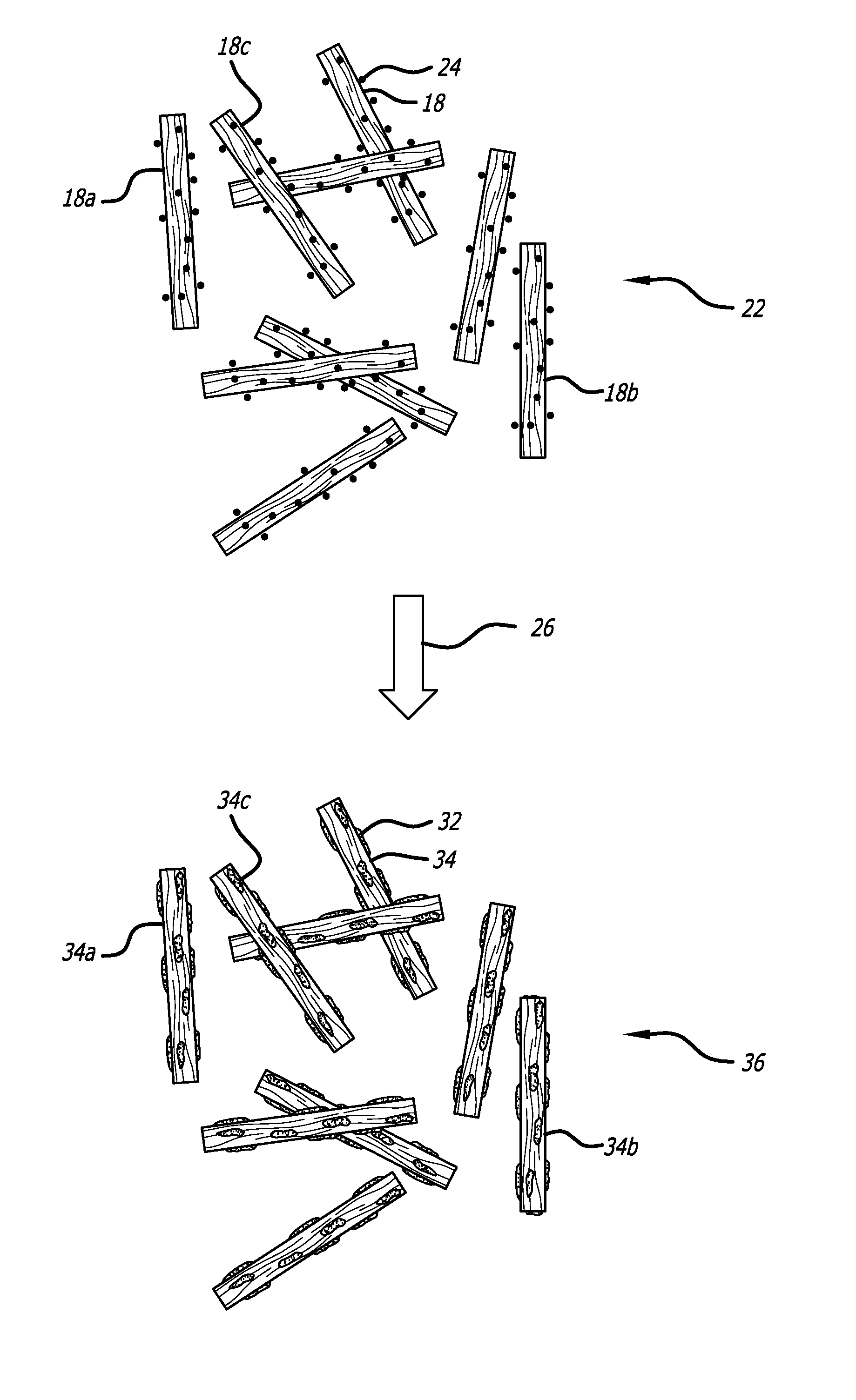Method for making a discontinuous fiber molding compound
a technology of discontinuous fibers and compounded fibers, applied in the field of molding compounds, can solve the problems of short remnant of carbon fiber tow, too short to be used in making woven or unidirectional fibrous structures, etc., and achieve good mechanical properties
- Summary
- Abstract
- Description
- Claims
- Application Information
AI Technical Summary
Benefits of technology
Problems solved by technology
Method used
Image
Examples
example 1
[0043]Groups of AS4C carbon fiber tows having 3K, 6K and 12K filaments were chopped into pieces using an ultrasonic knife. The carbon fiber tows were chopped into pieces of tow that were either about 2.5 cm or about 5 cm long. The carbon fiber tows were either AS4 fiber grade CP3000 or AS4 fiber grade CP4000 (Hexed Corporation—Dublin, Calif.). Linear weight of the 3K tows was 0.200 g / m with the linear weight of the 6K and 12K tows being 0.400 g / m and 0.800 g / m, respectively. The term “about”, when used in this specification is equal to the stated value plus or minus 5 percent.
[0044]Each group of chopped tow was mixed with a powdered epoxy resin in a rotary drum to provide blends of chopped carbon fiber tows and powdered thermosetting resin that contained about 38 weight percent epoxy resin based on the total weight of the molding compound. The powdered epoxy resin contained a combination of: 17 weight percent solid bisphenol A epoxy resin; 71 weight percent cresol novolac epoxy resi...
example 2
[0048]Ten laminates were made in the same manner as Example 1, except that the chopped 3K, 6K and 12K carbon fiber tows were combined in different proportions by weight to form discontinuous carbon fiber molding compounds that contained differing amounts of each type of tow ranging from 0 to 100 weight percent. All of the chopped pieces of carbon fiber tows were about 5 cm long and they were all made using AS4 Grade CP3000 carbon fiber tows. The composition in weight percent of the ten laminates is set forth in TABLE 2.
TABLE 2Laminate compositionLaminateAS4C 3KAS4C 6KAS4C 12KnumberCP3000CP3000CP300016717172505003500504171767505050633333371767178001009100001001000
[0049]The ten laminates were cured in the same manner as Example 1 and tested for tensile strength and tensile modulus. The results are set forth in TABLE 3.
TABLE 3Tensile StrengthTensile ModulusLaminate(MPa)(GPa)124939.7231945.0323935.7425839.9523637.8627842.5728944.2825841.4934840.41025341.1
[0050]As can be seen from TABLE ...
example 3
[0053]Three laminates were prepared and tested in the same manner as Example 1. The first laminate contained 100 weight percent IMA GS 12K chopped carbon fiber tow pieces that were 5 cm long. The second laminate contained 100 weight percent IM9 GP 12K (Hexcel Corporation—Dublin, Calif.) chopped carbon fiber tow pieces that were 5 cm long. The third laminate contained 50 weight percent of each of the carbon tow pieces used to make the first two laminates. The laminates were cured and tested in the same manner as Example 1. The test results are set forth in TABLE 5.
TABLE 5Tensile strengthTensile modulusILSSFiber type(MPa)(GPa)(Mpa)100% IMA GS 12K30348.65050% IMA GS 12K +32249.45050% IM9 GP 12K100% IM9 GP 12K3175054
[0054]As can be seen from Table 5, 12K IMA and IM9 carbon fiber tows can be used to make discontinuous carbon fiber molding compound that produces composite parts with mechanical properties that are similar to those obtainable using discontinuous carbon fiber molding compoun...
PUM
| Property | Measurement | Unit |
|---|---|---|
| softening point | aaaaa | aaaaa |
| softening point | aaaaa | aaaaa |
| tensile strengths | aaaaa | aaaaa |
Abstract
Description
Claims
Application Information
 Login to View More
Login to View More - R&D
- Intellectual Property
- Life Sciences
- Materials
- Tech Scout
- Unparalleled Data Quality
- Higher Quality Content
- 60% Fewer Hallucinations
Browse by: Latest US Patents, China's latest patents, Technical Efficacy Thesaurus, Application Domain, Technology Topic, Popular Technical Reports.
© 2025 PatSnap. All rights reserved.Legal|Privacy policy|Modern Slavery Act Transparency Statement|Sitemap|About US| Contact US: help@patsnap.com



